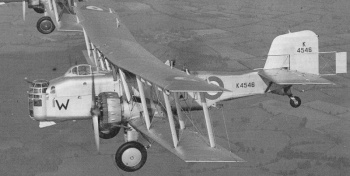Post by Diarist on Oct 22, 2015 12:44:44 GMT 1
The Boulton Paul P.75 Overstrand is the last of the twin-engine biplane medium bombers of the Royal Air Force, a series that had begun during the Great War with the likes of the Vickers Vimy and Handley Page Type O.
Design and development
The Overstrand is a development of the Boulton Paul Sidestrand, which first flew in 1928 and like the Sidestrand was named for a village in Norfolk, home also of Boulton Paul's Norwich factory. The Sidestrand is similar to its predecessors, in that it has open cockpits and hand-operated machine-guns. Unlike its predecessors, the Sidestrand could fly at 140 mph (225 km/h) making operating the guns in exposed positions difficult, particularly in the nose. The Overstrand is fitted with an enclosed and powered nose turret with a Lewis gun, the first RAF aircraft to have a power-operated turret. Rotation is by pneumatic motors, elevation and depression of the gun by hydraulic rams. The cockpit is also enclosed but the dorsal and ventral gun positions remain open, though shielded.
Operational history
The first Overstrand flew in 1933 as the Sidestrand Mk IV, powered by two 580 hp (430 kW) Bristol Pegasus IM.3 engines, instead of the 460 hp (340 kW) Bristol Jupiters in the Sidestrand and is capable of 153 mph (246 km/h). The bomb load has also increased to 1,500 pounds (680 kg). The conversion was a success and three more Sidestrands were modified using the 580 hp (430 kW) Bristol Pegasus II.M3. 24 Overstrands have been ordered and in 1936 will begin replacing the Sidestrand in No. 101 Squadron RAF, (the only Sidestrand squadron).
Source: Wikipedia - en.wikipedia.org/wiki/Boulton_%26_Paul_Overstrand
Design and development
The Overstrand is a development of the Boulton Paul Sidestrand, which first flew in 1928 and like the Sidestrand was named for a village in Norfolk, home also of Boulton Paul's Norwich factory. The Sidestrand is similar to its predecessors, in that it has open cockpits and hand-operated machine-guns. Unlike its predecessors, the Sidestrand could fly at 140 mph (225 km/h) making operating the guns in exposed positions difficult, particularly in the nose. The Overstrand is fitted with an enclosed and powered nose turret with a Lewis gun, the first RAF aircraft to have a power-operated turret. Rotation is by pneumatic motors, elevation and depression of the gun by hydraulic rams. The cockpit is also enclosed but the dorsal and ventral gun positions remain open, though shielded.
Operational history
The first Overstrand flew in 1933 as the Sidestrand Mk IV, powered by two 580 hp (430 kW) Bristol Pegasus IM.3 engines, instead of the 460 hp (340 kW) Bristol Jupiters in the Sidestrand and is capable of 153 mph (246 km/h). The bomb load has also increased to 1,500 pounds (680 kg). The conversion was a success and three more Sidestrands were modified using the 580 hp (430 kW) Bristol Pegasus II.M3. 24 Overstrands have been ordered and in 1936 will begin replacing the Sidestrand in No. 101 Squadron RAF, (the only Sidestrand squadron).
Source: Wikipedia - en.wikipedia.org/wiki/Boulton_%26_Paul_Overstrand

